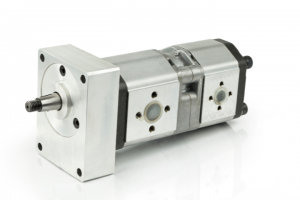
The hydraulic pump is the hardest working component of a hydraulic system, responsible for supplying the necessary pressure and flow to operate the system, making it an essential part of any hydraulic design setup. A key factor that determines how efficiently a pump works over time is its volumetric efficiency—but what exactly does that mean? Let’s look at what volumetric efficiency is and how to calculate it in variable displacement pumps.
What Is Volumetric Efficiency?
Volumetric efficiency is the ratio of how much fluid flows into the hydraulic pump compared to how much fluid gets pumped out. In other words, it measures how efficiently the pump can move fluid through itself and out into the system. The lower the volumetric efficiency rating, the less efficient your pump will be, costing more money and energy to generate the same output as a more efficient pump.
A lower-than-expected volumetric efficiency, or an unexpected drop in efficiency, may indicate a mechanical fault with your pump. It is natural and expected for the volumetric efficiency of the component to decline over time with successive cycles. However, we strongly recommend keeping a close check on your volumetric efficiency readings as part of your regular maintenance routine, in order to take the appropriate actions to sustain efficiency and avoid premature failure.
What Factors Affect Volumetric Efficiency?
There are various factors that can affect volumetric efficiency, including internal leakage of hydraulic fluid, changes in fluid viscosity, and operating temperature. Internal leakage occurs when hydraulic fluid leaks out of the pump before reaching its intended destination, resulting in reduced performance due to decreased pressure and flow rate.
With regard to viscosity, higher-viscosity fluids require more energy from the motor to move through the pump than lower-viscosity fluids do. This can result in increased waste heat generation (from friction) and decreased performance if not accounted for properly.
Calculating The Volumetric Efficiency Of A Variable Displacement Pump
A straightforward way to calculate the volumetric efficiency of a variable displacement pump is to divide the pump’s actual flow rate (at a given pressure in litres per minute) by its theoretical ‘out-of-the-box’ flow rate. The figure is then multiplied by 100 to give a volumetric efficiency reading as a percentage.
For example:
Actual flow /Theoretical flow @ (operating pressure in psi) x 100
80 litres per minute/100 L per minute @ (2000 psi) x100 = 80% efficiency
You will need to use a flow meter to gauge the actual flow rate of your hydraulic pump at the designated pressure. By understanding how efficient a pump is at using incoming fluid to generate mechanical power, engineers can make adjustments to optimise system performance and create more power for less energy input.
What Volumetric Efficiency Tells You About Internal Leakage
Volumetric efficiency not only measures how well your hydraulic pump is working, but also how much fluid you’re potentially losing through leakage, and any issues relating to fluid viscosity. As internal leakage and a decrease in volumetric efficiency are intrinsically linked, by addressing the causes of internal leaks and replacing any lost fluid, you can keep your volumetric efficiency as high as possible.
Volumetric Efficiency And Viscosity
The viscosity of a hydraulic fluid has an important impact on volumetric efficiency, and the volumetric efficiency of a pump can change significantly depending on what kind of fluid is used in it – and, for instance, if the fluid viscosity changes due to temperature fluctuations or contamination.
If no leaks are detected that could account for fluid loss, a drop in efficiency implies that the difference between the theoretical output and actual output is due to a change in viscosity. It is therefore essential to select a suitable fluid for any given application so that optimum performance can be maintained.
Find Out More
Addressing the root causes of volumetric efficiency in hydraulic variable displacement pumps requires accounting for both internal leakage and fluid viscosity to get an accurate reading on your overall volumetric efficiency percentage. By doing this regularly throughout the pump’s working lifespan, you can keep tabs on your hydraulic pump’s performance and ensure that it doesn’t underperform due to reduced volumetric efficiency over time.
To find out more about hydraulic system design and the factors that can affect pump efficiency, please call today on 01353 721704 .

